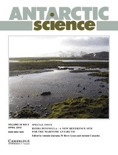
ANTARCTIC SCIENCE
Scope & Guideline
Pioneering Insights into Antarctic Environments
Introduction
Aims and Scopes
- Ecology and Biodiversity:
Research on the diverse ecosystems in Antarctica, focusing on species interactions, community structure, and the impacts of climate change on biodiversity. - Climate Change and Environmental Monitoring:
Studies assessing the effects of climate change on Antarctic environments, including glacial dynamics, sea ice changes, and long-term ecological monitoring. - Geology and Geochemistry:
Investigations into the geological history and processes in Antarctica, including sediment analysis, stratigraphy, and geochemical assessments of various formations. - Paleoclimatology:
Research exploring past climate conditions through the analysis of geological records, ice cores, and sediment samples to inform current climate models. - Human Impacts and Policy:
Examination of the social, political, and economic dimensions of human activities in Antarctica, including tourism, research policies, and conservation efforts. - Microbial and Extremophile Studies:
Exploration of microbial life and extremophiles in extreme Antarctic environments, contributing to understanding of life in extreme conditions. - Remote Sensing and Spatial Analysis:
Utilization of remote sensing technologies and spatial analysis tools to study Antarctic landscapes, biodiversity, and environmental changes.
Trending and Emerging
- Climate Change Impact Studies:
There is a marked increase in research focused on the impacts of climate change on Antarctic ecosystems, including shifts in species distributions, changes in glacial dynamics, and alterations in marine environments. - Biodiversity and Conservation:
Emerging themes emphasize the importance of biodiversity assessments and conservation strategies, particularly in light of increasing human activities and climate pressures. - Microbial Ecology and Extremophiles:
Research on microbial life and extremophiles has gained traction, reflecting interest in understanding life in extreme conditions and its implications for biotechnological applications. - Interdisciplinary Approaches:
Studies increasingly integrate various scientific disciplines, combining ecological, geological, and social science perspectives to address complex issues in Antarctic research. - Policy and Governance Research:
There is a growing emphasis on the intersection of science and policy, focusing on governance challenges, conservation strategies, and the implications of human activities in Antarctica. - Technological Innovations in Research:
The use of advanced technologies, including remote sensing, unmanned aerial vehicles, and metabarcoding, is on the rise, enhancing data collection and analysis in Antarctic research.
Declining or Waning
- Traditional Glaciology:
Although still relevant, traditional glaciology studies focusing solely on ice core analysis and glacier dynamics have seen a decrease as more interdisciplinary approaches become prevalent. - Historical Exploration Accounts:
Research emphasizing historical accounts of exploration in Antarctica has waned, as contemporary studies focus more on scientific data and environmental changes. - Single-Species Studies:
There is a diminishing focus on studies that examine single species in isolation, as the trend shifts towards understanding ecological interactions and community dynamics. - Static Habitat Studies:
Research that emphasizes static habitat assessments without considering dynamic ecological interactions or climate impacts is becoming less frequent. - Traditional Taxonomy without Molecular Techniques:
The reliance on traditional morphological taxonomy is declining, with a shift towards molecular techniques and genetic studies for species identification.
Similar Journals
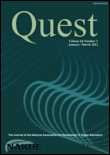
QUEST
Fostering collaboration between educators and sports scientists.QUEST is a distinguished academic journal published by Routledge Journals, Taylor & Francis Ltd, focusing on the intersection of education and sports science. Established in 1963, this peer-reviewed journal has built a commendable reputation, currently ranking in the Q1 category for Education and Q3 for Sports Science, showcasing its significant contribution to these dynamic fields. With a Scopus ranking of #311 out of 1543 in Social Sciences - Education, QUEST is recognized for its impactful research, embodying a 79th percentile rank that reflects its relevance and quality. The journal seeks to advance the understanding of teaching and learning across various contexts, making it an invaluable resource for researchers, professionals, and students alike, who are engaged in exploring the pedagogical implications of sport and physical culture. Be a part of the ongoing dialogue in education and sports science by accessing the latest in groundbreaking research and innovative practices through QUEST.

Nature Conservation Research
Connecting researchers and practitioners for a greener tomorrow.Nature Conservation Research is a prominent open-access journal that has been dedicated to advancing the field of conservation science since its inception in 2016. Published by the SARANSK FOND PODDERZKI & RAZVITIA ZAPOVEDNYH in the Russian Federation, this journal serves as a vital platform for researchers, professionals, and students alike, providing critical insights into ecological and environmental issues. With an impressive impact factor and ranked in the second quartile across multiple categories—including Agricultural and Biological Sciences, Earth and Planetary Sciences, Ecology, and Nature and Landscape Conservation—Nature Conservation Research stands at the forefront of impactful scientific discourse. The journal not only aims to disseminate high-quality research findings but also seeks to foster collaboration and innovation in conservation practices globally. By ensuring open access to its content, it promotes widespread dissemination of knowledge, crucial in the fight against biodiversity loss and environmental degradation. Researchers and practitioners contributing to the journal will find themselves at the convergence of science and conservation efforts, paving the way for sustainable ecosystem management.
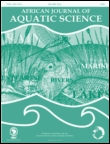
AFRICAN JOURNAL OF AQUATIC SCIENCE
Fostering dialogue in the realm of aquatic science.AFRICAN JOURNAL OF AQUATIC SCIENCE, published by TAYLOR & FRANCIS LTD, is a premier scholarly journal dedicated to the field of aquatic science, ecology, and environmental management, playing a crucial role in advancing research and knowledge in these vital areas. With an impressive Q2 ranking in both Aquatic Science and Ecology, Evolution, Behavior and Systematics, the journal seeks to publish high-quality research encompassing a wide range of topics related to freshwater and marine ecosystems, including biodiversity, conservation strategies, and the impacts of climate change. Featuring a rich history of publication from 2000 to 2024, the journal not only embraces rigorous peer review but also aims to foster collaboration and dialogue among researchers, practitioners, and students interested in aquatic environments. Readers will find that the journal’s commitment to impactful scientific communication is reflected in its notable rankings within the Scopus database, making it an essential resource for those engaged in aquatic research and management.
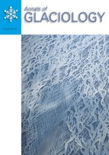
ANNALS OF GLACIOLOGY
Unveiling the Secrets of Our Planet's IceANNALS OF GLACIOLOGY, published by Cambridge University Press, is a premier open-access journal tailored for the field of glaciology and cryospheric sciences. Established in 1980, the journal has become a vital resource for researchers and professionals analyzing the multifaceted interactions between glaciers, ice sheets, and the Earth's climate system. With a commendable Q1 status in Earth-Surface Processes for 2023 and a commitment to open access since 2016, ANNALS OF GLACIOLOGY provides unparalleled visibility and accessibility for cutting-edge research, fostering global dialogue and innovation among scientists. The journal features a broad scope, encompassing both fundamental studies and applied research on glacial characteristics, behavior, and their environmental impacts. Located in Cambridge, England, this journal is particularly essential for those engaged in the ongoing exploration of our planet's cryospheric changes, their implications, and their relevance to climate science.

MARINE ORNITHOLOGY
Unveiling the Wonders of Seabirds and Their HabitatsMarine Ornithology, published by the Pacific Seabird Group, is a vital resource in the field of animal science, zoology, and oceanography. With an ISSN of 1018-3337 and E-ISSN of 2074-1235, this journal has been a cornerstone for researchers and enthusiasts since its inception, actively contributing to the understanding of marine bird species and their ecosystems. Although it is currently not an open-access journal, it provides critical insights and findings that inform both academic research and practical conservation efforts. With its category quartiles positioned in Q3 for both Animal Science and Zoology, and Oceanography, Marine Ornithology occupies a significant, albeit competitive niche among scholarly publications. Researchers can benefit from its comprehensive coverage of marine avian studies, which is crucial for addressing the challenges these species face in changing oceanic environments. As the journal continues to evolve, with coverage from 1990 to 2024, it maintains an essential role in enriching our knowledge of marine biodiversity.

Earth and Space Science
Exploring the Frontiers of Earth and Space.Earth and Space Science, published by the American Geophysical Union, is a distinguished open-access journal that has profoundly impacted the realms of earth and planetary sciences as well as environmental science since its inception in 2014. With impressive rankings, including Q1 in both Earth and Planetary Sciences and Environmental Science for 2023, this journal ranks 38th out of 195 in the general Earth and planetary sciences category and 51st out of 219 in environmental science, showcasing its commitment to high-quality research dissemination. The journal serves as a vital platform for researchers, professionals, and students, fostering the exploration of critical topics and advancements within these pivotal fields. With an accessible format, researchers can benefit from the rich content available, furthering their knowledge and ensuring that groundbreaking discoveries reach a broader audience. The journal's ongoing commitment to open access aligns with contemporary trends in scholarly communication, emphasizing inclusion and collaboration in tackling pressing global challenges.

Ocean Science Journal
Navigating the Frontiers of Marine ResearchOcean Science Journal, published by the Korea Institute of Ocean Science and Technology (KIOST), is a pivotal resource for scholars and practitioners in the field of oceanography. With the ISSN 1738-5261 and E-ISSN 2005-7172, this journal presents cutting-edge research from 2006 to 2024, bridging fundamental and applied ocean sciences. Based in South Korea, with its headquarters located in Busan, the journal has achieved a commendable Scopus rank of #72 out of 145 in the domain of Earth and Planetary Sciences, placing it in the 50th percentile among peer publications. Classified in the Q3 category of the 2023 Oceanography rankings, Ocean Science Journal offers a platform for innovative studies that advance understanding of marine environments and promote sustainable ocean practices. While it does not operate under an open access model, readers and contributors can expect high-quality, peer-reviewed material that addresses pressing oceanic challenges and developments. This journal serves as an essential tool for researchers, professionals, and students committed to fostering marine science and ocean technology.

Czech Polar Reports
Enhancing Understanding of Polar EcosystemsCzech Polar Reports, published by Masaryk University Press, is a pivotal academic journal dedicated to advancing research in the realms of Agricultural and Biological Sciences, Earth and Planetary Sciences, and Environmental Science. Since its inception in 2014, this peer-reviewed journal has established a solid reputation as a medium for disseminating innovative research, particularly in the unique environmental contexts of polar regions. With an impressive Q3 ranking in its designated categories by 2023, Czech Polar Reports serves as a valuable resource for researchers, professionals, and students seeking to deepen their understanding of ecological and climatic changes in these critical areas. While the journal is not fully Open Access, it aims to contribute substantially to ongoing scholarly dialogues and provide insights that are essential for sustainability and climate action. The journal's commitment to fostering interdisciplinary research underscores its importance in a rapidly evolving scientific landscape.
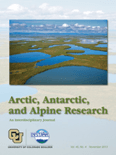
ARCTIC ANTARCTIC AND ALPINE RESEARCH
Illuminating the Dynamics of Earth’s Coldest FrontiersARCTIC ANTARCTIC AND ALPINE RESEARCH, published by Taylor & Francis Ltd, is a leading academic journal focused on the comprehensive study of polar and alpine environments, with an emphasis on the ecological, geological, and climatic processes unique to these regions. With an ISSN of 1523-0430 and E-ISSN 1938-4246, this open-access journal has been a vital resource for researchers and practitioners since it embraced open-access publishing in 2018, fostering a wider dissemination of knowledge. Recognized in the 2023 Scopus rankings as a Q2 journal in both Earth-Surface Processes and Ecology, Evolution, Behavior and Systematics, it also attains a Q3 ranking in Global and Planetary Change, highlighting its significant impact and relevance in these fields. The journal covers a span of converged years from 1996, providing a rich archive of research that meets the evolving needs of those engaged in environmental science. By addressing pressing issues such as climate change, biodiversity, and ecosystem dynamics in extreme environments, ARCTIC ANTARCTIC AND ALPINE RESEARCH serves as an indispensable platform for scholarly exchange and collaboration among scientists, policy-makers, and educators committed to advancing our understanding of these critical areas.

Earth Interactions
Exploring Earth’s Complex Systems Through Interdisciplinary ResearchEarth Interactions is a prominent journal that serves as a critical platform for interdisciplinary research in the field of Earth and Planetary Sciences. Published by the American Meteorological Society, this journal has established itself as a key resource for scholars, researchers, and professionals dedicated to understanding Earth's complex systems and their interactions. With an impressive Q1 ranking in the category of Earth and Planetary Sciences for 2023, it reflects a commitment to high-quality scholarship and impactful contributions to the field. The journal, with its dedicated coverage from 2004 to 2024, encompasses a wide array of topics, providing comprehensive insights into geological, atmospheric, and environmental phenomena. Although it operates under a non-open access model, its significance is underscored by its placement in the top percentile of Scopus rankings (Rank #89/195), making it an exciting resource for those pursuing advanced studies and applications related to Earth's systems.